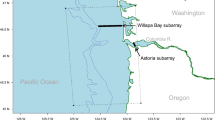Abstract
We consider a simple stochastic model for the dynamics of mixed-species waterfowl aggregations and describe two methods for assessing the fit of this model to field data. The model does not incorporate species-specific behavior. It assumes that all birds act independently and incorrectly predicts an exponential distribution for inter-event times. We reject this model, show that 29% of the birds move in groups of two or more birds, and demonstrate that the distribution of inter-event times between the movements of groups of birds is exponential. We find no difference in movement rates or group sizes between seasons, and no difference between groups arriving into or departing from the observed aggregations. An analysis of group composition suggests that species at low abundance behave differently than species at high abundance: birds with few conspecifics are more likely to move in mixed-species groups than birds with many conspecifics. We suggest that simple stochastic models provide a useful way to explore the dynamics of animal behavior.
Similar content being viewed by others
Author information
Authors and Affiliations
Additional information
Electronic Publication
Rights and permissions
About this article
Cite this article
Silverman, E.D., Kot, M. & Thompson, E. Testing a simple stochastic model for the dynamics of waterfowl aggregations. Oecologia 128, 608–617 (2001). https://doi.org/10.1007/s004420100684
Received:
Accepted:
Published:
Issue Date:
DOI: https://doi.org/10.1007/s004420100684




